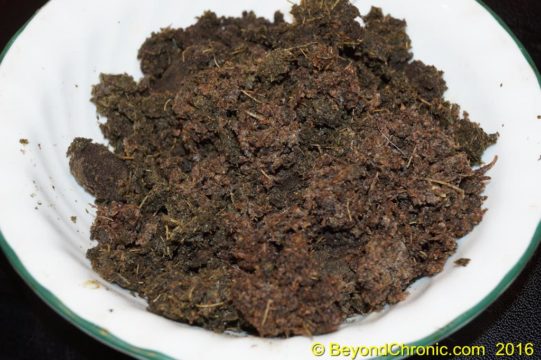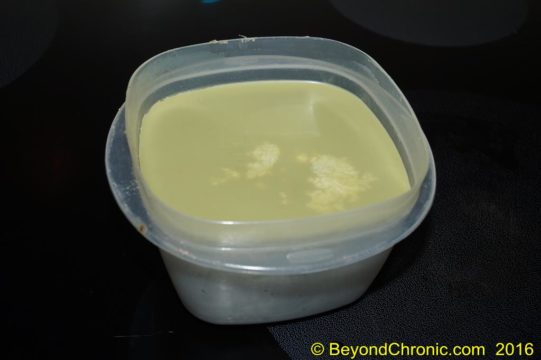You can buy cannabutter (cannabis cooked into butter) or oils infused with cannabis at a dispensary. Or you can make your own. These edibles can have a “greenish” or slightly bitter taste due to the chlorophyll and terpenes present in the plant matter (this can be almost completely removed by water curing).
How To Decarb Your Cannabis
Decarboxylating the plant material gets rid of some of this unwanted flavor, but is a necessary step to make your final product potent. Decarboxylating is a simple process: use a food dehydrator on low setting for two or three hours, or spread the bud or green fan leaves out thinly on a cookie sheet and heat in a preheated regular oven for half an hour at 250°F (121°C). We use this low temperature to prevent destroying the THC, but it must still be heated to change the molecular structure so our bodies can absorb it more efficiently.
Since all ovens have hot spots, and you don’t want the material to burn, keep checking on it every 15 minutes or so. You may have to shuffle it around on the sheet, or turn the sheet 180 degrees. You want the plant matter to become brown, crisp, and brittle. Once the plant matter has cooled a bit, it will be easy to grind. Plan ahead and microwave some popcorn to mask the smell if you like. 🙂
Food grade oils made from olives, soy, sesame, corn, peanut, palm, or coconut can all be used to infuse cannabis efficiently. THC is fat soluble, so it is the oils’ saturated fat content that makes this possible. Frying with infused oil, however, will burn off much of the THC.
How To Make Cannabutter
There is absolutely no great mystery about making cannabutter, because it’s exactly like making infused vegetable or nut oil. Simply use the first 7 steps in this article but ignore all the dosing and capsule instructions. No water is necessary, although some people like to add water as a kind of quick water cure, or to prevent it from burning on a stovetop. We do not recommend making any of this on a stovetop anyway: using an oven and Pyrex measuring cup works fine without drama or additional equipment.
The big mystery for some people, which is not their fault because it’s based on a 50-year-old urban legend, is why you need an entire ounce of weed and a pound of butter if they only want to make a little. Well, you don’t. That “ounce per pound” formula is not an exact command, it’s a ratio. That means it’s exactly the same potency when you use 1/4 ounce of weed per 1/4 pound (1 stick) of butter.
And actually, the original recipe/legend was based on using leaves in the first place, so you can cut those amounts in half if you’re using good bud (this means 1/8 ounce (3.5 grams) per 1/4 pound (100 grams) of butter). This will be plenty strong enough for almost anyone.
Cannabutter or infused oil is an edible by itself. As with any edible, watch out for overdosing from eating too much of the yummy foods. We mix non-cannabis foods with small amounts of the cannabis-laden foods on our plates any time we have some.
Cooking With Cannabis
So what to do once you have the cannabutter or oils? It is fairly obvious that you can bake with it, or just put cannabutter on bread, rolls or crackers, and cannabis oil on green salads. To enhance the food’s flavor (and to mask the “green” flavor), add a bit of lemon juice, ginger (powdered or cracked), garlic, pepper, or strong tasting herbs like rosemary, basil, sage, thyme, and oregano. Or like us, you may just get used to that “green” flavor. Here are some foods we have tried cannabis butter or oil on with varying success.
- homemade pizza (we also tried sprinkling ABV)
- pasta salad, potato salad, egg salad, anything we call “salad” (except fruit salad!)
- stir fry foods
- steamed vegetables (put cannabutter on as dressing after cooking)
- corn (boiled, barbequed, steamed) put cannabutter on as dressing after cooking
- chicken (use oil/marinade to coat after cooking!) barbeque, baked
- beef (use oil/marinade to coat after cooking!) barbeque,broiled
- fish (use oil/marinade to coat after cooking!) poached, baked
- shrimp (use oil/marinade to coat after cooking!)
- lobster (use oil/marinade to coat after cooking!)
- pasta and pasta sauces (use oil/marinade to coat after cooking!)
- making chocolates of varying kinds (melt one part cannabutter with two parts chocolate)
- warmed cinnamon buns
Remember, high heat destroys the THC and other cannabinoids. Since you generally have to cook meats at more than 225°F (107°C) to make them safe to eat, add any cannabis infusion/dressing/marinade to the meat after it is safely cooked.
We tested all of these at home. The beef was a little strange, but all the other foods tasted quite good. Initially, this is more of a gastronomic experience, rather than dosing medicinally. If you need a small amount of medicine on an ongoing basis, putting it on foods can help maintain you at a needed level. Keep a recipe book, in which you note how potent the infused butter or oil was (so you can replicate the recipe), as well as how much infused material you used on the foods. Only by careful record-keeping can this become a repeatable way to medicate yourself.





